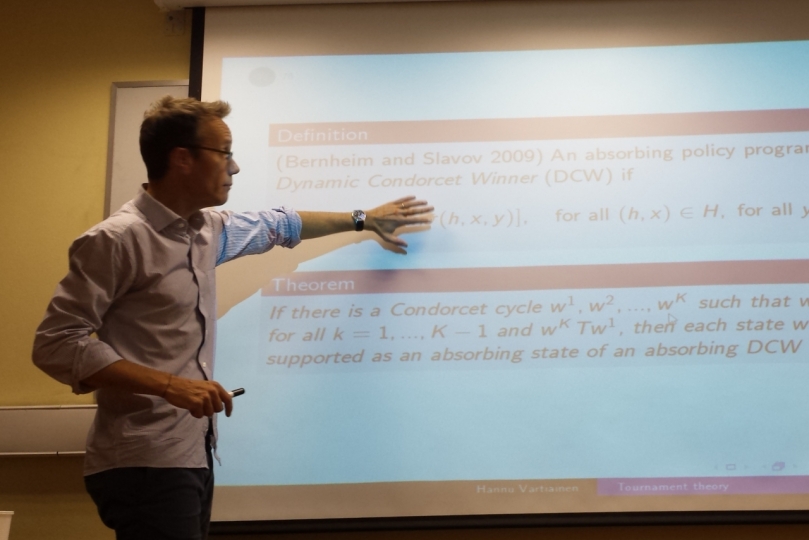Состоялись лекции профессора Ханну Вартиайнена
26 и 27 ноября 2015 года в здании НИУ ВШЭ на ул. Шаболовка состоялись лекции профессора Ханну Вартиайнена (Hannu Vartiainen, professor of microeconomic theory at the University of Helsinki and the director of Helsinki Center of Economic Research (HECER) на тему "Covering in tournaments".

Краткая информация о лекциях
A tournament is an asymmetric and total binary relation on a set of alternatives. For example, a group of tennis players form a tournament relation on the basis of pairwise comparisons. If there is no player who beats all the other players - which is often the case - how should one choose the best player(s)? The objective of a tournament solution is to answer this question. Understanding tournament theory is crucial for many applications in economics, voting theory, social choice theory, decision theory, and computer science.
One approach to solve the tournament is to explicitly impose institutional structure through which comparisons are made, and then apply non-cooperative game-theorety to ifentify the outcome of the process. Another is to consider methods other than maximality for the construction of choice sets. The objective of this mini-course is to form a general synthesis by combining the two approaches. The notion of covering is central to our endeavor.
A covering relation is a subrelation of a tournament relation. An element covers another if any pro.table move from the latter is also pro.table relative to the former (recall that the better-than relation is total). Intuitively, covered elements are fundamentally unstable in a sense that they are blocked by any reasonable mechanism that selects "good" outcomes. The covering relation is asymmetric and transitive, and its maximal set - the uncovered set - is nonempty under general conditions.
Remarkably, the notion of covering ties togeheter many seemingly distinct solution concepts in the tournament set up. We demonstrate that this is a consequence of an underlying property of the iterated version of the uncovered set: it exhausts all the blockings that cannot be justi.ed on strategic grounds.
We elaborate our argument by giving a compact overview of the recent literature on the notion of covering and its connections to the other solutions in social choice theory, game theory, and decision theory.
Covered topics:
1. Social choice theory and tournament solutions
2. Notion of overing, the uncovered set, the ultimate uncovered set
3. Covering set
4. Binary voting trees and farsighted voting
5. Downsian voting contest
6. Non-transitive choice behavior
7. von Neumann-Morgenstern stable set with history dependence
.jpg) | .jpg) |
Дополнительные материалы:
Лекция 1 (часть 1)
Лекция 1 (часть 2)
Лекция 2 (часть 1)
Лекция 2 (часть 2)
